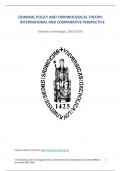Summary
Samenvatting Criminal Policy & Criminological Theory: International and Comparative Perspective,
- Course
- Institution
The document contains a summary of all the subject matter that was discussed during the lectures of the academic year. Texts not included in summary!
[Show more]



